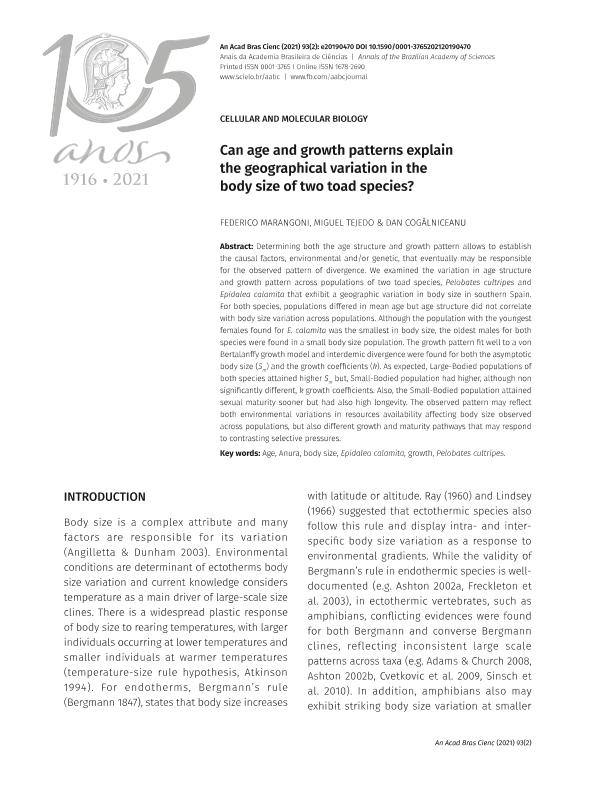Artículo
Can age and growth patterns explain the geographical variation in the body size of two toad species?
Fecha de publicación:
06/2021
Editorial:
Academia Brasileira de Ciencias
Revista:
Anais da Academia Brasileira de Ciencias
ISSN:
0001-3765
e-ISSN:
1678-2690
Idioma:
Inglés
Tipo de recurso:
Artículo publicado
Clasificación temática:
Resumen
Determining both the age structure and growth pattern allows to establish the causal factors, environmental and/or genetic, that eventually may be responsible for the observed pattern of divergence. We examined the variation in age structure and growth pattern across populations of two toad species, Pelobates cultripes and Epidalea calamita that exhibit a geographic variation in body size in southern Spain. For both species, populations differed in mean age but age structure did not correlate with body size variation across populations. Although the population with the youngest females found for E. calamita was the smallest in body size, the oldest males for both species were found in a small body size population. The growth pattern fit well to a von Bertalanffy growth model and interdemic divergence were found for both the asymptotic body size (Sm ) and the growth coefficients (k). As expected, Large-Bodied populations of both species attained higher Sm but, Small-Bodied population had higher, although non significantly different, k growth coefficients. Also, the Small-Bodied population attained sexual maturity sooner but had also high longevity. The observed pattern may reflect both environmental variations in resources availability affecting body size observed across populations, but also different growth and maturity pathways that may respond to contrasting selective pressures.
Palabras clave:
AGE
,
ANURA
,
BODY SIZE
,
EPIDALEA CALAMITA
,
GROWTH
,
PELOBATES CULTRIPES
Archivos asociados
Licencia
Identificadores
Colecciones
Articulos(CCT - NORDESTE)
Articulos de CTRO.CIENTIFICO TECNOL.CONICET - NORDESTE
Articulos de CTRO.CIENTIFICO TECNOL.CONICET - NORDESTE
Citación
Marangoni, Federico; Tejedo, Miguel; Cogalniceanu, Dan; Can age and growth patterns explain the geographical variation in the body size of two toad species?; Academia Brasileira de Ciencias; Anais da Academia Brasileira de Ciencias; 93; 2; 6-2021; 1-19
Compartir
Altmétricas




